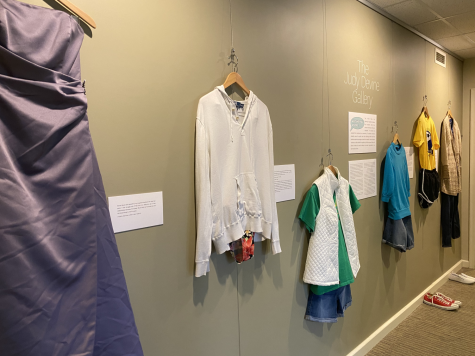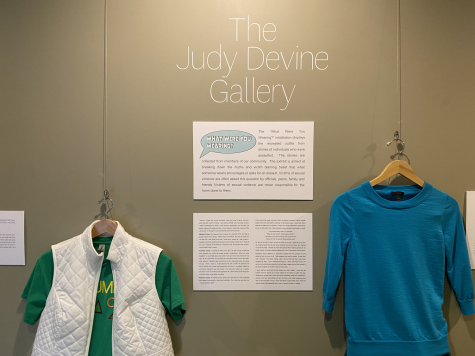Kent State art exhibit opens conversation around sexual assault
April 9, 2022
Editor’s note: The following story contains mention of sexual assault.
A long purple prom dress hangs on a wall in Kent State’s Williamson House. Beside it a quote reads: “If that’s what love is, then I don’t want it.”

This quote closes a story told by a survivor who had been sexually abused and assaulted by her boyfriend for two years. The whole time he claimed he loved her.
The purple dress is one of six outfits recreated by the Center for Sexual and Relationship Violence Support Services for the “What Were You Wearing” exhibit. Each outfit was reproduced based on a story submitted by a sexual assault survivor in the Kent State community. The stories represent survivors of various ages and situations.
“We’re trying to recreate and stay as true as what was given to us,” said the director of SRVSS, Jennifer O’Connell.
“What I Was Wearing,” a poem written by Mary Simmering about her personal experience with sexual assault, sparked the initial exhibit at the University of Arkansas in 2013. Since then, other universities have created their versions based on survivors’ stories in their own communities. This is Kent State’s first time creating a “What Were You Wearing” exhibit.
“We’re trying to address that myth we know survivors hear all the time,” O’Connell said.
The myth: what one wears affects whether they are sexually assaulted.
“When someone chooses to assault someone, they’re doing it because of the power and control they want to have over the other person, not what the person’s wearing,” O’Connell said.

The trend of placing blame on the victim of a sexual crime, also known as victim-blaming, has become prevalent in recent years, largely due to social media. Barbara Gilin, a professor of social work at Widener University, told The Atlantic that people tend to believe they have some control over crimes that happen to them. These same people believe victims of sexual assault bear partial responsibility. The “What Were You Wearing” exhibit is designed to change that thought process.
“I think it’s important to look at stuff like this because there is such a negative stereotype around victim blaming,” said sophomore finance major Natalie Lambert. “When it really comes down to it, it’s all about consent.”
The exhibit is on the Judy Devine Gallery Wall in the Williamson House. It is open from April 7-12 with SRVSS staff available to talk at any time.
“I feel like it’s very eye opening for anyone,” said freshman finance major Lauren Stillwagon. “Reading the stories is hard.”
SRVSS is still accepting survivors’ stories with the goal of expanding the exhibit next year. Submitting a story does not prompt a university investigation, and all stories are published anonymously.
Jenna Bal is a reporter. Contact her at [email protected].











